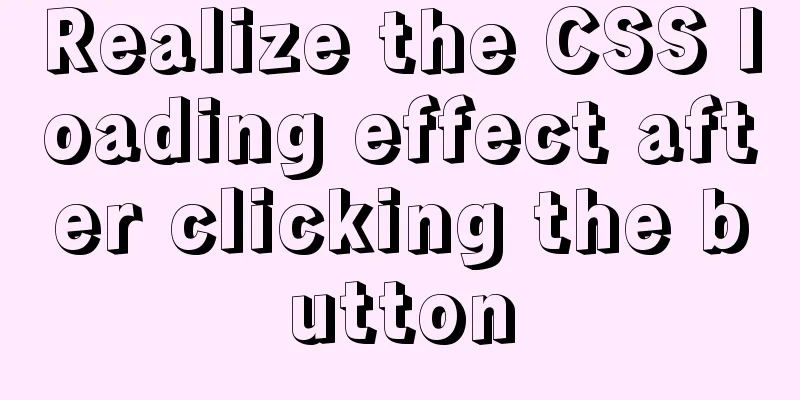Realize the CSS loading effect after clicking the button

|
Since there is a button in my company's product that has a one or two second waiting time after clicking (to send a verification email), in order to avoid the one or two second loading window after clicking, I made a loading animation to enhance the user experience. I originally wanted to solve it directly with a gif, but I wanted to take this opportunity to practice, so I used the CSS gradient effect to achieve it. Unexpectedly, the effect is quite good, and there is no need to add additional elements such as div. It can be completed by simply modifying the CSS and adding click events. Effect Demonstration Let’s take a look at the finished effect first.
Implementation process This effect is actually very easy to create. Let’s first take a look at the original button. It’s just a div with CSS applied. HTML: <div class="btn">click me</div> CSS:
.btn{
position:relative;
width:200px;
height:30px;
line-height:30px;
text-align:center;
border-radius:3px;
background:#5ad;
color:#fff;
cursor:pointer;
}It will look like this (just very simple CSS):
So how do you add animation on it? At this time, you need to use CSS pseudo-elements, cover a before pseudo-element on top, and put the animation in this pseudo-element. CSS:
.btn::before{
content:"loading";
position:absolute;
width:200px;
height:30px;
line-height:30px;
text-align:center;
border-radius:3px;
z-index:2;
top:0;
left:0;
color:#fff;
text-shadow:rgba(100,0,0,1) 0 0 3px;
background:#c00;
}After putting on before, you will find that the original one is covered.
After understanding the principle, the next step is to change the background of before to animation. Two CSS3 techniques are used here. The first is the gradient background, and the second is animation. The first gradient color is more complicated. The main thing is to let the gradient fill in a 45-degree manner. The content is that the two colors match each other, but it must be coordinated with background-size so that the gradient can be smoothly connected. This is usually the place that takes the longest time to adjust. background:linear-gradient(45deg,#fc0 0%,#fc0 20%,#fa0 20%, #fa0 45%,#fc0 45%,#fc0 70%,#fa0 70%, #fa0 95%,#fc0 95%,#fc0 100%); background-size:30px 30px; background-position:0 0; As you can see from the picture below, if you don’t adjust it step by step, the resulting appearance may not be well connected, but if the adjustments are completed, the connection will be smooth.
After completion, you need to apply the CSS3 animation effect to change the background-position, and the background will change automatically.
animation:click 1s infinite linear;
@keyframes click {
0%{
background-position:0 0;
}
100%{
background-position:30px 0;
}
}
At this point, 80% of the work is done. The last step is to add a click event. What I do here is to hide the pseudo-element with display:none, and then add a class called click. When you click the button, the button will be applied with the click class, and the pseudo-element will appear. The following is the complete code, but it has been simplified a bit, and the button will return to its original state after 2 seconds of clicking. CSS:
.btn,.btn::before{
width:200px;
height:30px;
line-height:30px;
text-align:center;
border-radius:3px;
}
.btn{
position:relative;
background:#5ad;
color:#fff;
cursor:pointer;
}
.btn::before{
content:"loading";
position:absolute;
display:none;
z-index:2;
top:0;
left:0;
color:#fff;
text-shadow:rgba(100,0,0,1) 0 0 3px;
background:linear-gradient(45deg,#fc0 0%,#fc0 20%,#fa0 20%, #fa0 45%,#fc0 45%,#fc0 70%,#fa0 70%, #fa0 95%,#fc0 95%,#fc0 100%);
background-size:30px 30px;
background-position:0 0;
animation:click 1s infinite linear;
}
.btn.click::before{
display:block;
}
@keyframes click {
0%{
background-position:0 0;
}
100%{
background-position:30px 0;
}
}jQuery:
$(function(){
var timer;
$('.btn').on('click',function(){
$('.btn').addClass('click');
clearTimeout(timer);
timer = setTimeout(function(){
$('.btn').removeClass('click');
},2000);
});
});
The above is the full content of this article. I hope it will be helpful for everyone’s study. I also hope that everyone will support 123WORDPRESS.COM. |
<<: The difference between html block-level tags and inline tags
>>: Vue uses Canvas to generate random sized and non-overlapping circles
Recommend
How to configure /var/log/messages in Ubuntu system log
1. Problem Description Today I need to check the ...
Comprehensive interpretation of MySQL master-slave replication, from principle to installation and configuration
Why do we need master-slave replication? 1. In a ...
Fixed table width table-layout: fixed
In order to make the table fill the screen (the re...
jQuery to achieve sliding stairs effect
This article shares the specific code of jQuery t...
Advertising skills in the Baidu Union environment (graphic tutorial)
Recently, students from the User Experience Team o...
Solve the problem of MySql8.0 checking transaction isolation level error
Table of contents MySql8.0 View transaction isola...
The most complete package.json analysis
Table of contents 1. Overview 2. Name field 3. Ve...
How to set default value for datetime type in MySQL
I encountered a problem when modifying the defaul...
Analysis and solution of Chinese garbled characters in HTML hyperlinks
A hyperlink URL in Vm needs to be concatenated wit...
Detailed explanation of the idea of implementing dynamic columns in angularjs loop object properties
Angularjs loop object properties to achieve dynam...
What does href=# mean in a link?
Links to the current page. ------------------- Com...
Eight common SQL usage examples in MySQL
Preface MySQL continued to maintain its strong gr...
MySql COALESCE function usage code example
COALESCE is a function that refers to each parame...
Detailed steps for embedding Baidu Maps in web pages and using Baidu Maps API to customize maps
Insert Baidu Map into the web page If you want to...
Vue implements the right slide-out layer animation
This article example shares the specific code of ...














